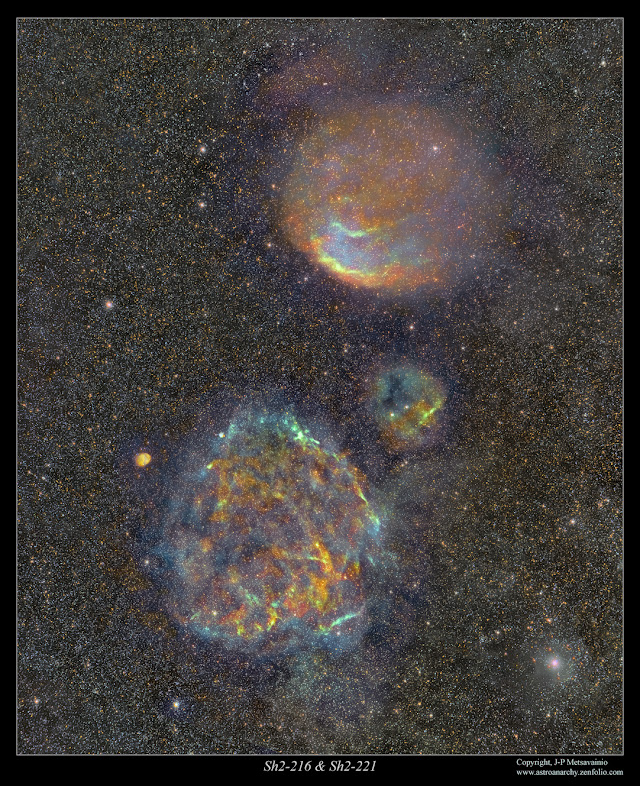COPYRIGHT, PLEASE NOTE
All the material on this website is copyrighted to J-P Metsavainio, if not otherwise stated. Any content on this website may not be reproduced without the author’s permission.
BUY A MUSEUM QUALITY POSTER
BUY A POSTER:https://astroanarchy.zenfolio.com/
Wednesday, April 1, 2020
Two ways to go in a same field of view, planetary nebula Sh2-216 & supernova remnant Sh2-221
I have reprocessed this photo from March 1 2020, now the composition is more dynamic and colors are more vivid. Original photo can be seen here, https://astroanarchy.blogspot.com/2020/03/two-ways-to-die-sh2-216-sh2-221.html
This must be one of the dimmest targets I have shot. The supernova remnant Simeis 147 is large and dim but this nebula pair in Auriga is much dimmer. There are very few images about this target around. Photo is taken with Tokina AT-x 300mm f2.8 camera lens and Apogee Alta U16 astro camera.
Supernova remnant and a planetary nebula in the same field of view
Click for a large photo, it's worth it!
Image spans about six degrees horizontally, at left lays the large and very dim planetary nebula Sharpless 216 (aka Simeis 288, Marsalkova 44, LBN 742, GN 04.41.3)
This planetary nebula is the closest known planetary nebula to Earth, about 390 light years, and also one of the oldest known. Due the old age, it's very diffused, dim and large, apparent diameter is about 1,6 degrees. (Full Moon is about 0,5 degrees wide)
At right side of the photo lays a dim nad diffused supernova remnant Sh2-221 (SNR G160.4+02.8, HB9) it locates in constellation Auriga, about one degree West from star Capella. (Doesn't show in my image) The distance from the Earth, 2600 light years, is determined recently at 2007. This object was recognized as a supernova remnant back at seventies.
H-alpha, 36 x 1200 s, binned 1x1 = 12 h
O-III, 33 x 1200 s, binned 2x2 = 11 h
S-II, 9 x 1200 s. binned 2x2 = 3 h
An experimental starless image
Click for a large photo
Mapped colors from the emission of ionized elements, R=Sulfur, G=Hydrogen and B=Oxygen.
Image spans about six degrees vertically!
Photo in visual spectrum
Click for a large photo
The red glow from an ionized hydrogen (H-alpha) is dominating the view, bluish hues are from an ionized oxygen (O-III)
H-alpha image
INFO
Sh2-216, the closest planetary nebula to earth ever discovered.
Image spans about six degrees horizontally, at left lays the large and very dim planetary nebula Sharpless 216 (aka Simeis 288, Marsalkova 44, LBN 742, GN 04.41.3)
This planetary nebula is the closest known planetary nebula to Earth, about 390 light years, and also one of the oldest known. Due the old age, it's very diffused, dim and large, apparent diameter is about 1,6 degrees. (Full Moon is about 0,5 degrees wide)
Supernova remnant Sh2-221
At right side of the photo lays a dim nad diffused supernova remnant Sh2-221 (SNR G160.4+02.8, HB9) it locates in constellation Auriga, about one degree West from star Capella. (Doesn't show in my image) The distance from the Earth, 2600 light years, is determined recently at 2007. This object was recognized as a supernova remnant back at seventies.
Technical details
Processing workflow
Image acquisition, MaxiDL v5.07.
Stacked and calibrated in CCDStack2.
Deconvolution with a CCDStack2 Positive Constraint, 33 iterations, added at 50% weight
Color combine in PS CS3
Levels and curves in PS CS3.
Imaging optics
Tokina AT-x f2.8 camera lens
Mount
10-micron 1000
Cameras and filters
Imaging camera Apogee Alta U16 and Apogee seven slot filter wheel
Guider camera, Lodestar x 2 and an old spotting scope of Meade LX200
Astrodon filters,
5nm H-alpha 3nm S-II and 3nm O-III
5nm H-alpha 3nm S-II and 3nm O-III
Total exposure time 26h
H-alpha, 36 x 1200 s, binned 1x1 = 12 h
O-III, 33 x 1200 s, binned 2x2 = 11 h
S-II, 9 x 1200 s. binned 2x2 = 3 h
Orientation in Auriga
An experimental starless image
Click for a large photo
Subscribe to:
Post Comments (Atom)














No comments:
Post a Comment